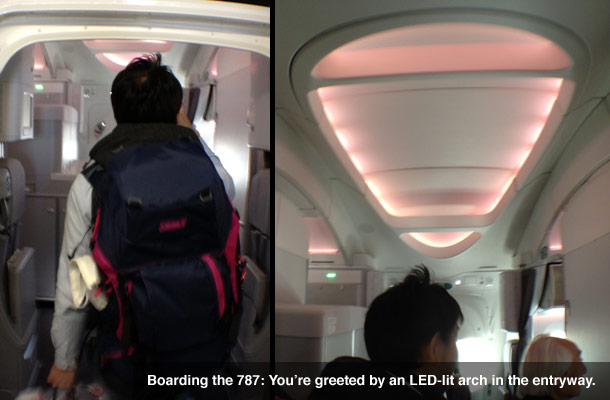
With huge, futuristic, “smart glass” windows, colorful LED lights, and big TV screens, Boeing’s new 787 ‘Dreamliner’ isn’t just a new plane, it’s a great new gadget for passengers.
Late last month, Japan Airlines launched the first 787 route to the United States, from Tokyo to Boston. Come along for the journey and see what it’s like inside Boeing’s newest, high-tech airplane.
Flying the Dreamliner
The first step in my adventure was to get to Boston. One of the main purposes of the 787, which has a long flight range but is not that large, is to connect city pairs like Tokyo-Boston that wouldn’t make sense with bigger or less-efficient aircraft. A key route like New York-Tokyo can handle multiple flights per day with huge planes. But with the smaller, efficient 787, Boston residents can now enjoy direct service to Tokyo, too.
The 787 is special because it’s the first major commercial airplane to be built mostly from carbon-fiber-composite material instead of metal. This makes it lighter. Coupled with two brand-new engines, it’s about 20% more fuel efficient than the similar-sized 767, which debuted 30 years ago. In today’s airline industry, where fuel costs have crippled profits, that makes a huge difference. And all of a sudden, Boston-Tokyo is a possibility.
Onboard the 787
As you might expect, especially from a high-end airline like JAL, the 787 is up-to-date. It’s not a huge plane, like Airbus’s double-decker A380, so you won’t find private, first-class suites, showers, or anything silly like that.
But there are accoutrements like (supposedly!) a Toto “washlet” toilet in the business-class bathroom; colorful LED lighting; and large, personal TVs for everyone on the plane. The coach seat itself was fine, including a footrest that I didn’t notice until after landing, and a couple of pockets to store earbuds, iPhone, etc. But the under-seat storage was too tight even for my small backpack, and there was a huge box for the in-flight entertainment system that took up valuable leg-stretching space.
Perhaps the most noticeable cabin feature is the new window design. The windows are the biggest in the industry, and don’t have typical plastic, pull-down windowshades. Instead, they’re “smart glass” with a dimming switch under each window. With five different settings, you can make the window brighter or darker with the push of a button. It takes a few moments for the shading to adjust, but it works pretty well. Even at the darkest setting, the windows are still transparent-blue, so you can see outside without waking your neighbor. But it’s dark enough to sleep next to. Science!
After a smooth takeoff, almost 90 minutes into the flight, we were served dinner. In economy class, there was a choice between Japanese seafood curry and some sort of cheesy chicken with pasta and vegetables. I chose the chicken, which was… what you’d expect in coach. At least JAL trusted us with real, metal utensils. Later in the flight, some sort of pastry snack was handed out. And then before landing, we received lunch: More cheesy pasta. But who’s flying for the food? Anyway, no special menu for the 787, at least not in coach.
The large personal TVs worked, and the real-time map looked great. (Though the user interface was poorly designed and a bit confusing, and JAL couldn’t handle my high-end, noise-isolating earbuds. It’s still using those old ones that split the audio into two jacks.) But I couldn’t find any movies or videos that took advantage of the high-resolution screen. If anything, they looked worse than they would on a smaller screen. I’m not sure if that’s a technical hurdle or a business hurdle, but if you’re going to offer HD screens, it would help to have HD streams. There was also a selection of Japanese comic books, some radio stations, and games. And a USB charger, which I used to keep my iPhone fresh. (It didn’t seem to have enough juice to charge an iPad.)
In general, I wasn’t really impressed with the entertainment features, though it would be easy for JAL to make software and content improvements here. Eventually, I’d expect satellite-based wi-fi on these planes. But maybe that’s also a good thing: It allowed me to sleep most of the flight.
The ride itself was nice. It’s refreshing to be on a new airplane, with new seats, nicer bathrooms, and big windows. One of the features of the 787 is that it’s pressurized to simulate a lower altitude, and has higher humidity. Those aren’t night-and-day changes, but my contact lenses didn’t seem to dry out as much as they do on a typical long-haul flight, so maybe that’s why. There wasn’t much turbulence, but when there was some chop, the plane handled it silently. On older planes, there’s a familiar sound – like a bouncing school bus – when the wings make noise and the overhead bins rattle. On the 787, not a peep. I don’t know if that will change as the planes age, but it was interesting.
In general, though, while the 787 is an important plane for the airlines – and especially for Boeing – it’s an “evolutionary” upgrade for the passenger. Flying, especially in coach, is still mostly the same. But I’d take the larger windows any day. And if the 787 means more nonstop routes to more places, and burning less fuel to get there, that sounds great.
The Airline Industry Is Still Waiting For Its iPhone
When Apple’s iPhone launched five years ago, it changed everything in the mobile industry: The user experience; the balance of power between phone-maker, carrier, and customer; the pecking order in the handset industry; everything. The 787 won’t do that. Neither will Airbus’s forthcoming A350.
Perhaps it will be a while before an ‘iPlane’ launches, but maybe eventually? It would be great to experience flight – either the experience, or the economics, or something – in a way that hasn’t yet been imagined or implemented. But with fuel costs where they are, and airlines mostly competing on ticket price, I’m not holding my breath. It’s nice to have little incremental upgrades like the 787 in the meantime.
Boeing’s long-delayed 787 rollout means its early customers have only started receiving their planes over the past few months. But over the next several years, many airlines are set to receive them. So there’s a good chance you’ll fly one this decade, for your own giant-gadget review. Try a window seat and enjoy the view.
Read more : Flying the 787 ‘Dreamliner’: What It’s Like to Ride Boeing’s Newest Airplane
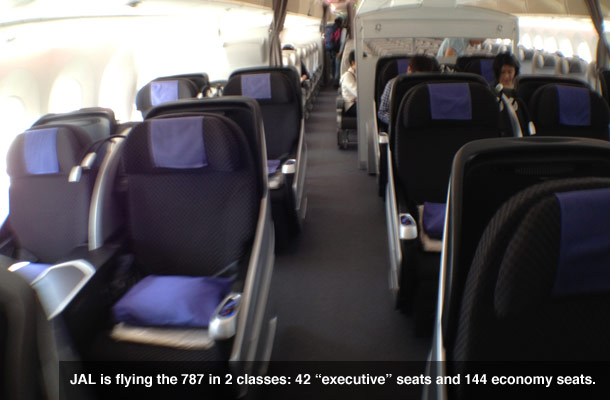
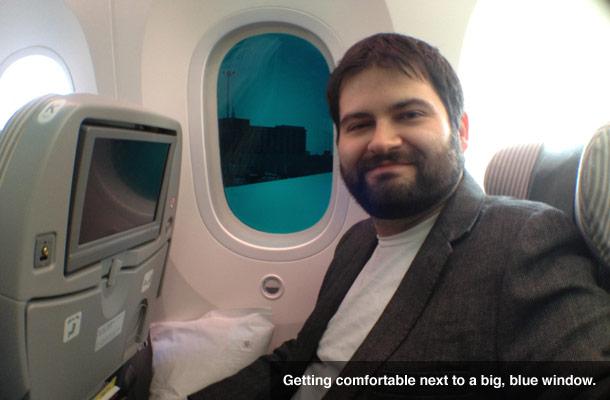
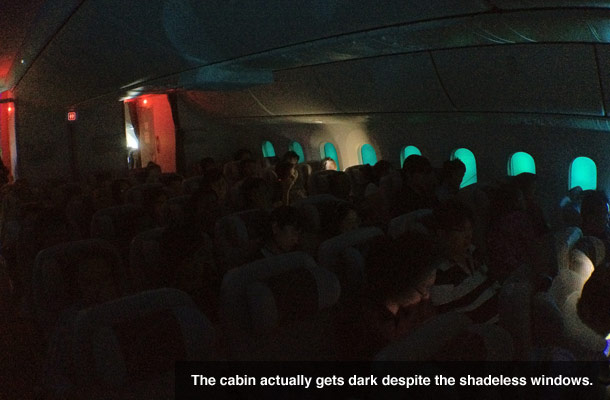

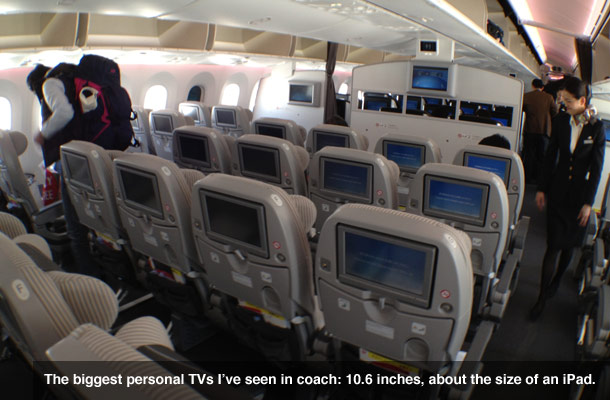
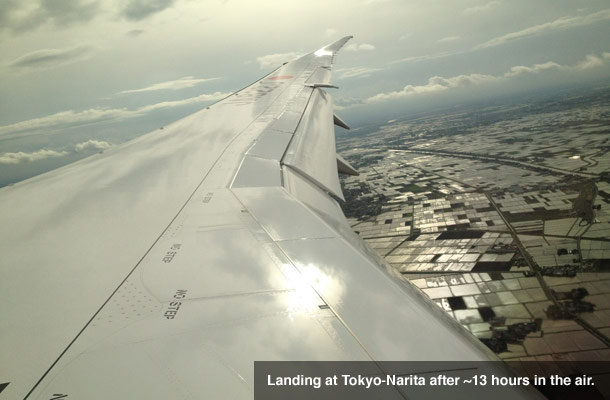

0 Responses
Stay in touch with the conversation, subscribe to the RSS feed for comments on this post.